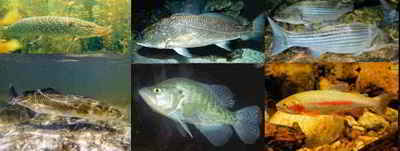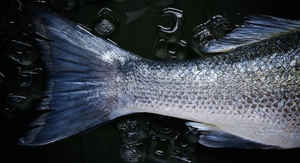New York State Marine or Salt Water Fish
Striped Bass

(Morone saxatilis)
Adopted on August 16, 2006 .
The striped bass, (Morone saxatilis,) was adopted as the State marine or saltwater fish of New York in 2006. Striped bass are found seasonally in the tidal portion of the Hudson River and coastal waters around Long Island.
Also called bass, linesiders, stripers, and rockfish, striped bass are a prized recreational game fish. Striped bass have a life expectancy of at least 30 years and can grow to over 4 feet. It takes 5 to 8 years for a female to reach sexual maturity, and females tend to grow much larger than the males.
New York State Marine or Salt
Water Fish:
Striped Bass

Striped bass or "stripers" are the largest of New York's temperate basses. They are easily distinguished by the seven to nine dark horizontal lines found along their sides, two to three of which extend from the head to the base of the tail. Unlike white bass or white perch, stripers have a streamlined body shape, with the depth of the body generally less than the head length. In addition, striped bass have two patches of teeth on the tongue.
Striped bass are found in both fresh and saltwater. They generally occur around rocks and wrecks in nearshore waters, rivers and large reservoirs. Striped bass are found along the Atlantic Coast from the St. Lawrence River in Canada to the St. Johns River in Florida. In New York State, they are found seasonally in the tidal portion of the Hudson River and coastal waters around Long Island.
Stripers are migratory fish. In the ocean, they move north in the summer and south in the fall and winter. Striped bass found along the mid-Atlantic coast are produced in the Hudson and Delaware rivers, the Chesapeake Bay system, and the Roanoke River. Hudson River striped bass are most commonly found between New Jersey and Cape Cod. However, they can travel as far away as North Carolina and Nova Scotia.
Striped bass vary considerably in size, ranging from 18 to 55 inches in length and three to 70 pounds in weight. They are slow to mature and are long lived. In New York, female stripers do not mature until five to eight years old and fish 25 years old have been caught in the Hudson River.
Smaller striped bass in the ten to 20 pound range generally travel in large schools. Older and larger fish are usually in small "pods" of only a few fish. Adult striped bass are voracious feeders, primarily eating fish and invertebrates, especially crabs and squid.
Striped bass are anadromous, migrating to freshwater from the sea to spawn. Spawning takes place in the Hudson River estuary in May and early June. Stripers broadcast their eggs near the surface over deep water that has some current or turbulence. The semi-buoyant eggs drift with the current and hatch in two to four days. By early summer, young striped bass move to shallow water nursery areas of Haverstraw Bay and the Tappan Zee. In early fall, they begin to move out of the estuary to nearshore coastal areas. Adult stripers leave the estuary right after spawning and join other striped bass migrating along the Atlantic Coast.
Striped bass are a favorite of many New York anglers. Since stripers are know to occur around rocky areas near jetties and dropoffs where there is some current or turbulence, anglers should concentrate their efforts there. Many of these areas can be found by studying a good set of navigation charts. Best fishing is around high tide in the evening, at night, or on overcast days.
Anglers use a variety of methods and tackle to catch these incredible fighters. On the Hudson River, striped bass fishing is best during the spring spawning run from March to June. During the early spring, when water temperatures are cooler (about 50 degrees Fahrenheit) and the bass are less active, bottom fishing on slow drifts with blood worms provides some success. As the water warms up (above 56 degrees Fahrenheit), trolling with lures such as jointed plugs or bait is the most effective method for catching Hudson River stripers. Although boat fishing provides the best catches, shore anglers also take their share of fish. Jigs and plugs retrieved on a fast cast may catch a striper warming itself in shallow water areas during high tides.
In saltwater, boat anglers catch the most stripers by trolling or controlled drifting using large plugs or spoons or fresh cut bait or eels. For surf fishing along Long Island, casting plugs, spoons or jigs may produce good catches. Surf casters should fish on a moving tide.
Striped bass have been a valuable commercial fish species in New York. Unfortunately, striped bass from New York were found to contain polychlorinated biphenyls (PCBs). Levels were highest in bass from the Hudson River and in 1976, the state banned their sale. PCB levels have dropped significantly since then, but remain above the federal action level of two ppm. The presence of PCBs also led to a ban in the 1980s on the sale of striped bass from the marine waters around Long Island. This has been partially lifted and a limited fall commercial fishery is now permitted.
Common Names
Striper, Rockfish, Linesides
Characteristics of the Striped Bass.
Striped bass have a dark, olive-green to bluish-black back and silvery-white sides and belly. There are 7 to 8 black, unbroken, horizontal stripes along the side. Temperate basses have two dorsal fins (the first with usually nine spines and the second with one spine), three anal spines, a large mouth, ctenoid scales, thoracic pelvic fins, a large spine on the gill cover and a small gill on the underside of the gill cover. These fishes are pop
Typical Adult
20-30 inches, 3-10 pounds. Striped bass can live in excess of 30 years under good habitat conditions and light fishing pressure. Hence they have the potential to reach 48 inches and 60 - 100 lbs or better.
Habitat
Striped bass are an anadromous species of fish. Anadromous fish inhabits both fresh water and salt water, depending on the time of year. Striped bass live in the Atlantic and Pacific coastal waters and the Gulf of Mexico but enter freshwater streams to spawn. The preferred water temperature is 65-75°F. Striped bass are found seasonally in the tidal portion of the Hudson River and coastal waters around Long Island. Adult striped bass prefer water temperatures less than 75 degrees F and will often lose weight and suffer additional health problems when forced to live under warmer conditions. Their over riding selection for temperature can isolate them from prey and acceptable levels of oxygen. The striped bass is an anadromous species distributed along the Atlantic coast from northern Florida to the St. Lawrence estuary. It has been successfully introduced in numerous inland lakes and reservoirs and to the Pacific coast, where it now occurs from Ensenada, Mexico to British Columbia.
Feeding Behavior
The diet of striped bass consists mostly of soft-rayed fish. Preferred species in fresh water are threadfin shad, gizzard shad and blueback herring. Striped bass commonly herd schools of prey fish against the surface, where their frenzied feeding can splash water several feet in the air. The heaviest feeding times are at dawn and dusk.
Reproductive Behavior (Spawning)
Prior to spawning in early spring, striped bass migrate up rivers. Spawning occurs when water temperatures reach 60-70°F. Adults swim up tributary streams and spawn below dams or natural obstructions such as rock formations. The semi-buoyant eggs are released iin light to moderate current and fertilized by several males in a thrashing event known as a "fight". As many as 3,000,000 eggs may be released by one female. The eggs require a flow adequate to prevent their settling to the bottom during the incubation period of approximately 50 hours. During their first few days of life the larval fish are sustained by a yolk material while they continue to develop until they can feed on zoo plankton. Adults do not guard the eggs.
New York State Assembly 2006 Summary
Designating an Official State Marine Fish
(Chapter 541 of the Laws of 2006/A.11171, Saladino)
This law will designate the striped bass, also known as morone saxatilis, as the official salt water fish of the State of New York. The striped bass
is a hugely popular, highly sought after fish that is native to the Hudson River and the regions surrounding New York City and Long Island. As such,
it is fitting to designate the striped bass as the official state marine fish.
New York Law
The law designating the striped bassas the official New York state salt water fish is Section 80-A of the New York State Consolidated Laws, STL - State, Article 6 (ARMS AND GREAT SEAL OF STATE) Section 80-A.
STL - State.
Article 6 - ARMS AND GREAT SEAL OF STATE.
SECTION 80-A - State marine or salt water fish.
§ 80-a. State marine or salt water fish. The striped bass (Morone saxatilis) shall be the official marine or salt water fish of the state
of New York.
Taxonomic Hierarchy: Rockfish - Striped Bass
Kingdom: Animalia - animals
Phylum: Chordata - chordates
Subphylum: Vertebrata - vertebrates
Class: Actinopterygii (ray-finned fishes)
Order: Perciformes (perch-likes)
Family: Moronidae (Temperate basses)
Genus: Morone
Species: Morone saxatilis








